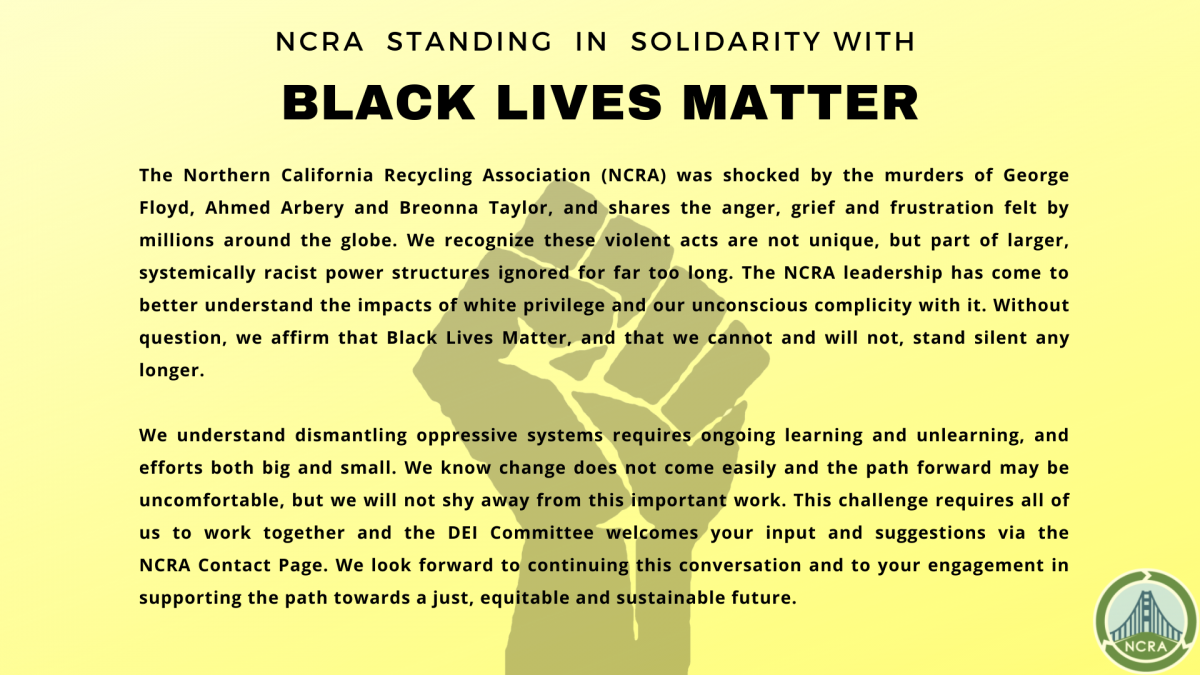Prepared by the DEI Committee, 10/5/2020
Short Version
The Northern California Recycling Association (NCRA) was shocked by the murders of George Floyd, Ahmed Arbery and Breonna Taylor, and shares the anger, grief and frustration felt by millions around the globe. We recognize these violent acts are not unique, but part of larger, systemically racist power structures ignored for far too long. The NCRA leadership has come to better understand the impacts of white privilege and our unconscious complicity with it. Without question, we affirm that Black Lives Matter, and that we cannot and will not, stand silent any longer.
We understand dismantling oppressive systems requires ongoing learning and unlearning, and efforts both big and small. We know change does not come easily and the path forward may be uncomfortable, but we will not shy away from this important work. This challenge requires all of us to work together and the DEI Committee welcomes your input and suggestions via the NCRA Contact Page. We look forward to continuing this conversation and to your engagement in supporting the path towards a just, equitable and sustainable future.
Longer Version
The Northern California Recycling Association (NCRA) was shocked by the murders of George Floyd, Ahmed Arbery and Breonna Taylor and shares the anger, grief and frustration felt by millions around the globe. We recognize these violent acts are not unique, but part of larger, systemically racist power structures ignored for far too long. The NCRA leadership has come to better understand the impacts of white privilege and our unconscious complicity with it. Without question, we affirm that Black Lives Matter, and that we cannot and will not, stand silent any longer.
Through a continuous effort of learning and unlearning, NCRA is deepening our understanding of how the socially constructed concept of race is a tool used to strengthen power structures that suppress and exploit the Black community through discriminatory policies and practices. We are committed to actively work towards dismantling these human-made systems of injustice, and building a society that celebrates diversity, lifting up the voices of Black people and all who suffer from systemic oppression.
NCRA’s mission is to end waste, but our vision is broader. We strive for an equitable future that sustains ecosystems so they may provide benefits to all people – regardless of age, race, gender identity, sexual orientation, class, ability, language, or cultural background. We know that climate and environmental justice are inherently tied to social justice and that systemic racism and the resulting social, physical, and economic inequalities have significant impacts in the wasting, reuse, and recycling industries. We seek to engage and elevate those most impacted by systemic racism as we cannot solve our most pressing environmental problems without listening to their voices, ideas and solutions.
In the Fall of 2019, after receiving challenging feedback regarding a lack of DEI awareness and procedures, NCRA established the Diversity, Equity, and Inclusion (DEI) Committee to drive meaningful change across all aspects of our work. We understand dismantling oppressive systems requires ongoing learning and unlearning, and efforts both big and small. We know change does not come easily and the path forward may be uncomfortable, but we will not shy away from this important work. This challenge requires all of us to work together and the DEI Committee welcomes your input and suggestions via the NCRA Contact Page. We look forward to continuing this conversation and to your engagement in supporting the path towards a just, equitable and sustainable future.
# # #


